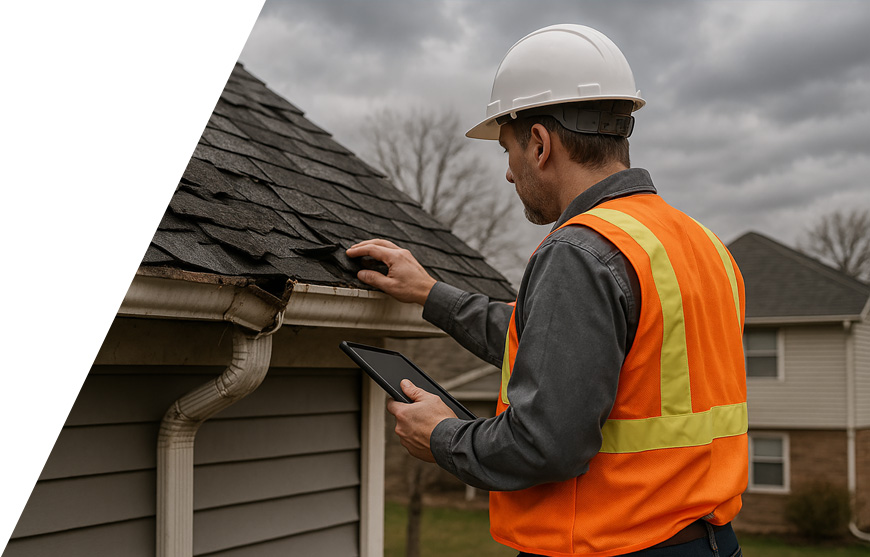Getting consistent leads from insurance companies can transform your roofing business from reactive to proactive. When disaster strikes and homeowners file claims, smart contractors position themselves as the go-to professionals insurance companies trust. This comprehensive approach combines relationship building, strategic networking, and exceptional service delivery to create a steady pipeline of qualified leads¹.
Modern roofing contractors no longer wait for the phone to ring. Instead, they actively cultivate relationships with insurance professionals and expand their service offerings to become indispensable partners in the claims process. This guide explains how to get roofing leads from insurance companies to boost revenue.
Preview: Your Path to Insurance Company Leads
- Build strategic networks with adjusters and agents through industry events
- Expand your service portfolio with comprehensive storm damage inspections
- Master the insurance process to speak their language fluently
- Leverage technology to streamline operations and customer service
- Establish professional credibility that insurance companies can trust
How to Get Roofing Leads from Insurance Companies: Essential Strategies
Different approaches to insurance lead generation require varying levels of time investment and deliver different success rates. Understanding these trade-offs enables contractors to select the optimal combination of strategies that aligns with their business objectives.
Primary Lead Generation Methods for Insurance Contracts
| Strategy | Time Investment | Success Rate | Best For |
| Direct outreach to adjusters | 2-3 hours/week | High (75%+) | Established contractors |
| Industry event networking | 3-4 days/year | Very High (85%+) | Growth-focused businesses |
| Professional referral program | 1 hour/week | Medium (60%+) | Relationship builders |
| Comprehensive inspection services | Ongoing | High (80%+) | Service-oriented contractors |
| Technology integration | Set-up time only | Medium-High (70%+) | Efficiency-focused teams |
The most successful roofing contractors combine multiple strategies rather than relying on a single approach². Companies that utilize integrated networking and service expansion report 47% higher lead conversion rates compared to those using traditional marketing methods alone.
Building Professional Networks with Insurance Professionals
The foundation of successful insurance lead generation lies in building authentic relationships. Insurance adjusters and agents work with dozens of contractors, but they consistently refer work to those they trust and know will deliver quality results.
Strategic Networking Approaches:
Start by identifying key insurance companies operating in your service area. Research their local offices, claims managers, and preferred contractor lists. Many insurance companies maintain public databases of approved contractors, providing insight into current partnerships.
Professional associations offer direct access to insurance professionals. The National Association of Independent Insurance Adjusters (NAIIA) hosts regional conferences where contractors can meet adjusters face-to-face³. Similarly, state insurance contractor associations provide networking opportunities with company representatives.

Industry Events for Maximum Impact:
The roofing and insurance industries host numerous events throughout 2024 and 2025. The International Roofing Expo (February 2024, Las Vegas) brings together thousands of contractors and insurance professionals⁴. The Texas Roofing Conference (September 2024) focuses specifically on storm damage restoration and insurance partnerships.
Regional events often offer more effective networking opportunities than national conferences. Florida’s Roofing & Sheet Metal Expo and the Midwest Roofing Contractors Conference offer intimate settings for building meaningful professional relationships⁵.
Comprehensive Service Portfolio Development
Expanding your service offerings beyond basic repairs makes you more valuable to insurance companies and justifies premium pricing. The following matrix illustrates how various inspection services contribute value to both insurance companies and contractors.
Storm Damage Inspection Services Matrix
| Service Type | Insurance Value | Contractor Benefit | Frequency |
| Emergency roof assessments | 💲💲💲💲 | Immediate revenue | Post-storm |
| Comprehensive damage reports | 💲💲💲 | Professional credibility | Every claim |
| Preventive maintenance inspections | 💲💲 | Relationship building | Annually |
| Code compliance evaluations | 💲💲💲 | Differentiation factor | As needed |
| Multi-trade damage assessment | 💲💲💲💲 | Premium pricing | Major events |
Modern insurance companies require detailed documentation and technical expertise. Contractors who offer comprehensive storm damage inspections with professional reporting stand out from basic repair services⁶.
Expanding Beyond Basic Roofing
Smart contractors develop expertise in related areas that insurance claims often cover. This includes assessing gutter systems, evaluating siding damage, and assessing interior water damage. Insurance adjusters prefer working with contractors who can handle multiple aspects of storm damage rather than coordinating several different trades.
Consider obtaining certifications in specialized areas, such as infrared moisture detection or drone inspection services. These technical capabilities position you as a premium service provider and justify higher project values.
Mastering the Insurance Claims Process
Understanding insurance company procedures and terminology sets professional contractors apart from competitors. Adjusters work with specific forms, deadlines, and approval processes that vary by company and the type of claim being processed.
Essential Insurance Knowledge:
Learn the difference between actual cash value (ACV) and replacement cost value (RCV) claims. ACV payments consider depreciation, while RCV covers full replacement costs. This knowledge helps you communicate effectively with both adjusters and homeowners⁷.
Understand common claim denial reasons and how to address them proactively. Age-related deterioration, improper installation, and maintenance issues often lead to claim rejections. Document pre-existing conditions clearly to separate storm damage from normal wear.
Building Trust Through Professionalism:

Insurance adjusters value contractors who consistently follow procedures. Submit complete documentation packages, meet deadlines reliably, and communicate changes promptly. These professional habits distinguish reliable partners from unreliable vendors.
Maintain detailed photo documentation of all work phases. Insurance companies are increasingly requiring visual proof of the extent of damage and the progress of repairs. High-quality images with timestamps and location details support claim approvals and protect both parties from disputes.
Technology Integration for Competitive Advantage
Modern technology platforms deliver measurable improvements across multiple aspects of your business operations. These benefits translate directly into stronger relationships with insurance companies and higher customer satisfaction scores.
Customer Service Technology Benefits
| Technology Feature | Customer Impact | Insurance Value | Business Benefit |
| Real-time project updates | Higher satisfaction | Transparent process | Reduced callbacks |
| Digital documentation system | Professional experience | Complete records | Faster approvals |
| Automated scheduling | Convenient appointments | Reliable timelines | Better resource planning |
| Mobile payment processing | Seamless transactions | Quick settlements | Improved cash flow |
Modern field service management platforms revolutionize the way roofing contractors interact with insurance companies and homeowners. Zuper for Roofing provides an AI-native, all-in-one solution that manages everything from initial inspections to final payments⁸.
Learn more about leveraging AI to Improve Customer Service.
Streamlined Operations
Technology integration eliminates paperwork bottlenecks and communication gaps that frustrate insurance professionals. Zuper’s platform integrates customer relationship management with field service operations, ensuring that nothing falls through the cracks during claims processing.
The system automatically generates professional reports, maintains photo documentation, and tracks project timelines to ensure seamless progress. Insurance adjusters receive consistent updates and can access complete project histories when questions arise.
Enhanced Customer Experience
Homeowners dealing with insurance claims often feel overwhelmed by the process. Professional technology platforms provide transparency and reassurance during stressful situations. Automated notifications keep customers informed about appointment schedules, project progress, and payment status.
Superior customer service leads to positive reviews and referrals, which insurance adjusters take note of when selecting contractors for future claims. Companies using integrated technology platforms report 23% higher customer satisfaction scores compared to those using manual processes⁹.
Professional Credibility and Reputation Management
Insurance companies conduct thorough due diligence before adding contractors to preferred provider lists. They evaluate licensing, insurance coverage, financial stability, and a history of customer satisfaction.
Building Strong Credentials
Maintain current licenses in all service areas and carry comprehensive insurance coverage, including general liability, workers’ compensation, and professional indemnity. Many insurance companies require minimum coverage amounts before considering partnership applications.
Seek industry certifications that demonstrate technical expertise. Certifications from GAF, Owens Corning, or other major manufacturers signal professional competence to insurance adjusters.
| Credential Type | Required For | Renewal Frequency | Typical Cost |
| State Contractor License | All insurance work | 2-4 years (varies by state) | $200-$800 |
| General Liability Insurance | Preferred contractor lists | Annual | $2,000-$5,000 |
| Workers’ Compensation | Any employee work | Annual | $1,500-$4,000 |
| Professional Indemnity Insurance | High-value claims | Annual | $800-$2,500 |
| Contractor Bond | Large commercial claims | Annual | $300-$1,000 |
| GAF Master Elite Certification | Premium manufacturer claims | Annual | $500-$1,200 |
| Owens Corning Preferred Contractor | Shingle warranty work | 2 years | $400-$900 |
| HAAG Residential Roof Inspector | Storm damage assessment | 5 years | $1,800-$2,200 |
| FAA Part 107 Drone License | Aerial damage documentation | 2 years | $150-$300 |
| OSHA 10-Hour Safety Training | Jobsite safety compliance | 5 years | $50,$150 |
Leveraging Customer Success
Positive customer experiences have a ripple effect throughout the insurance industry. Satisfied homeowners recommend contractors to their agents, who then refer additional business to them. This organic growth pattern proves more valuable than traditional advertising for generating insurance leads.
Track and document customer satisfaction metrics, project completion times, and quality scores to ensure ongoing improvement. Insurance companies increasingly use data-driven selection criteria for contractor partnerships.
Conclusion
Generating roofing leads from insurance companies requires a strategic, multifaceted approach that extends beyond basic service delivery. Success stems from cultivating genuine professional relationships, expanding service capabilities, and leveraging technology to deliver exceptional customer experiences.
The most successful contractors combine active networking at industry events with comprehensive service portfolios and professional technology platforms, such as Zuper for Roofing. This integrated approach creates sustainable competitive advantages, generating consistent leads and higher-value projects.
Schedule a Demo with Zuper for Roofing to discover how to get roofing leads from insurance companies with an all-in-one platform.



